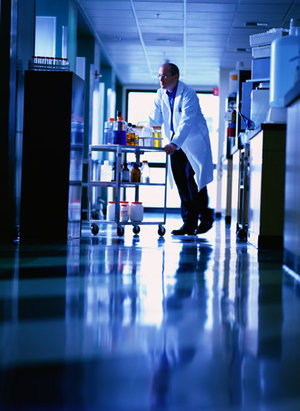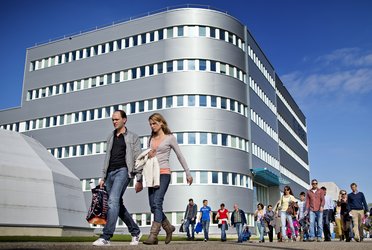How are the Materials and Components Laboratories equipped?
The Laboratories house a unique collection of specially-designed facilities to assess the properties and performance of materials and components being considered for spaceflight. These include
Tensile machines to establish the mechanical force needed to deform, break or fracture test items, together with environmental chambers and vacuum furnaces capable of operating at a range of temperatures from -150° C to 1500° C. To assess the surface resistance of very thin films and coatings less than a micrometre (a millionth of a metre) thick, special nano scratcher and nano indenter test rigs are utilised whereby a diamond headed stylus produces a carefully-controlled surface scratch or indentation.
Purpose-built vacuum chambers are employed to perform outgassing tests, along with dynamic outgassing systems that apply charged particles to speed surface vaporisation. In addition the Laboratories are equipped with various spectroscopic equipment and a gas chromatograph to identify and measure the resulting vapour materials.
A range of advanced space simulation chambers enable thermal cycling, UV and radiation exposure testing of materials while in vacuum conditions.
Radiation test facilities investigate the effects of radiation on electronic components. A Cobalt-60 isotope recreates the degradation resulting from a lifetime radiation dose.
The Laboratories' atomic oxygen simulator is without parallel in Europe. To create atomic oxygen in the same neutral state that it occurs in at the top of the atmosphere, heat is pumped into a tank of oxygen using a laser to split its molecules apart. A valve is then opened to expose the test item. Exposure effects can be accelerated by a factor of up to a thousand.
Other environmental chambers are employed for corrosion testing, including saltspray and humidity effects as well as galvanic corrosion, where adjacent metals within a structure set up unwanted electrical currents which can induce corrosion.
To investigate the results of testing a numbered of specialised microscopes are available above and beyond standard optical designs, including scanning electron microscopes (SEMs), stereo and confocal microscopes for 3D vision and a pair of acoustic microscopes that employ ultrasound for examination of the interior of materials in a non-destructive way.
Specialised preparation tools enable the preparatory cutting, drilling and grinding needed for microscopic examination. The Laboratories also house two tomographical X-ray systems that can reconstruct the three-dimensional internal volume of a component on a non-invasive basis, typically employed as a first step in deciding how to take it apart for other analysis techniques.
In addition the Laboratories oversee an affiliated network of external European laboratories. Close contact is maintained with other facilities to maintain and develop knowledge of novel materials, components and processes.
External laboratories also assist with investigations the Laboratories are not directly equipped to perform, such as micrometeoroid impacts and the flammability testing mandated for human spaceflight payloads.
In the past, the Laboratories have even had an on-orbit annex, overseeing the running of the Materials Exposure and Degradation ExperimenT (MEDET), which between 2007 and 2009 gathered in-situ outgassing and degradation data from the exterior of ESA's Columbus module aboard the International Space Station.










